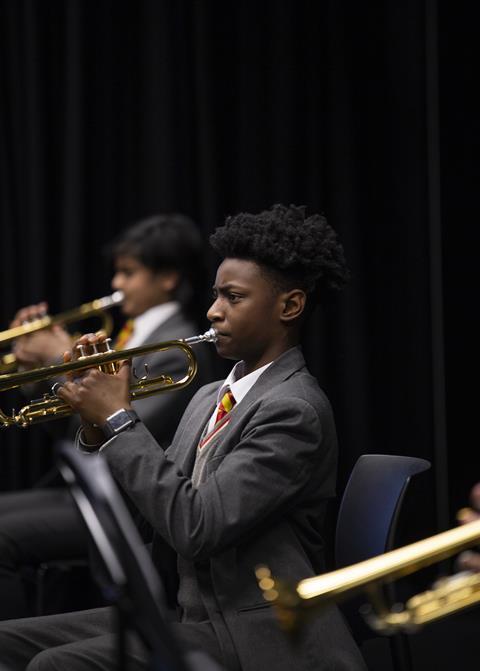Violist with the Bath Festival Orchestra, Cameron Howe, shares his experiences of teaching teenagers as part of the orchestra’s outreach work

Explore more teaching guides in The Strad Education Hub
I finished a postgraduate degree at the Royal Academy of Music in 2021 before I began playing with the Bath Festival Orchestra (BFO) and taking part in its educational programme. Elsewhere, a significant majority of my time teaching violin and viola has been in group lessons: I taught at the Renaissance Arts Academy, a not for profit performing arts charter school in Los Angeles where all subjects are taught in a manner that emphasises and celebrates ensemble learning.
From my experience, here are 5 ways to engage teenage string students in learning music and music performance:
1. Group classes when and where possible
I could not encourage teachers to find ways to do group classes enough. In my experience with group classes, I’ve found that students are much more comfortable being themselves when they’re around their peers than they are in individual lessons. We have a weekly string ensemble at the Bobby Moore Academy, and through this the students have been able to build relationships, improve their ensemble skills, and it’s been important for their personal growth.
Group classes provide an opportunity to cultivate a culture of empathy, openness and friendship akin to that of a tight knit football or soccer team. As an example of this, my top viola class were frustrated that the same people sat up front and in the back for most of their orchestra rehearsals, and so they proposed to make their own seating rotation to ensure that everyone got to experience leading and playing from the back of the section equally. It was a brilliant idea that ultimately made the section stronger, provided perspective on different roles in a section, and eventually inspired other sections to follow suit.
Read: ‘Is it too late for me?’: Teaching adult students
Read: Teaching adult students: Find a teacher with passion and dedication
2. Same instrument ensemble music
One shortcoming of individual lessons is playing music with other people. While technically my whole class playing the Courante from Bach’s G major Cello Suite together was them playing with one another, it leaves no room for the wonderful spontaneity and dialogue that comes with chamber music. I am constantly on the lookout for pieces composed or arranged for multiple violas. A friend introduced me to a book of very accessible rounds and canons by William Starr, which includes some really lovely arrangements that less-experienced classes can play in harmony together, and some that advanced classes can use to work on phrasing and intonation.
When we work on pieces as part of the education programme ‘Orchestrate’, students create their own arrangements inspired by the BFO’s repertoire. Instrumental groups break off to explore their instrument together, and to generate musical material inspired by but independent of the piece that they are studying. These ideas are recorded and transcribed into orchestral arrangements where students celebrate the fruits of their creative labour.
For my advanced viola class, I found an arrangement of Vivaldi’s Concerto for Four Violins in B minor that they absolutely rocked out on, as well as a really beautiful piece for solo viola and four violas by John Cage. They rearranged this to split the solo viola part more equitably amongst the parts and eventually memorised it to perform alongside contemporary dance choreography while walking around the performance space. These pieces were great because the students got to play some really fine music with one another and we were still able to focus on particular aspects of viola technique that wouldn’t be useful to explore in their afterschool ensemble rehearsals with other instruments.

3. Encourage students to keep a practice journal
One of the things that I wish I had more confidence to ask about in my lessons growing up was simply how does one practice. I spent so many hours banging my head on the same passage, repeating bars that didn’t need work only to crash and burn at the same area that needed TLC. I never thought to share my frustrations with my teachers, who would have easily identified my mistake of practising material that didn’t need work while focusing on chunks that were far too long.
Older and somewhat wiser, I insist my students keep honest practice journals where they log exactly what worked out, what seemed to work, and what they were still struggling with, especially if they didn’t understand a particularly tough passage - whether the infamous octave arpeggios in the opening of Stamitz’s Viola Concerto, or tricky technical challenges in Bartok’s String Quartet no. 2. As an additional bonus, their log books eventually become historical documentation of their progress, and a really useful positive reinforcement whenever someone is feeling particularly down about their playing. Simply take a look back in their log to remind them how much progress they have actually made, even if in the moment they have a feeling of plateauing.
4. Be yourself
Another key aspect of my teaching training was being authentic with the students. Teenagers are inexplicably able to see through the counterfeit persona that some teachers put on. The BFO musicians foster the musical development of the Bobby Moore Academy students - students predominantly from communities with restricted accessibility to be able to feel like music is something that they have the option to do.
The same high energy, sing-songy voice that can (sometimes) captivate younger pupils will bore 16-year-olds. Teachers who lack the confidence to be themselves in front of the students will struggle to build the connection and trust necessary for students to be able to take the constructive criticism that will inevitably be necessary. I learned very quickly that I couldn’t fake a cool teacher vibe, and instead owned my inner nerdiness for music and the viola. Students saw me get genuinely excited teaching the viola part in the variations of the second movement of Beethoven’s Fifth, and get comically carried away demonstrating the accents in the third etude of Mazas op. 36.
I demonstrated that the studio was a safe place to be myself, and in turn a safe place for them to be vulnerable with each other in a way that made for some pretty fantastic music-making and instrumental study. Any students who were a bit too cool eventually saw how much fun we were all having and ended up not wanting to miss the bus. One Orchestrate student listened to a piece by Tchaikovsky and said, ’Wow. People my age who don’t like classical music just haven’t had the opportunity to explore it. I feel bad for them. This is amazing.’
5. Don’t try to anticipate what they will learn or ‘get’
Lastly, and this one is important, never ask leading questions. Questions like ’Are these two bars the same?’ or ’Do you think you were a bit sharp there?’ or ’Do you see a sudden accelerando in this notey passage?’ immediately take away students’ opportunity for autonomous discovery. Instead, opt for more open-ended inquiry such as: ’Can you compare these two bars?’ or ’What did you think about your intonation there?’ and ’I noticed you sped up here, was that intentional?’ In all three revisions, you give the student more room to use their own tools of analysis and their responses will in turn give you much more information.
For instance, if they say they weren’t aware of any intonation issues where you clearly heard some, that could be a sign that intonation work would be useful for them, or that you might need to be more direct and help them identify when they are too sharp or flat.
Consistent, gentle, and direct communication is crucial to building trust with students so that they will be more open to asking questions without fear of judgement. After playing a side-by-side concert with a BFO oboist, one violin student from the school has now decided that she wants to become a professional musician and attend conservatoire when she is older.
Read: Musical groundbreakers: Ševčík’s female pupils
Read: Leila Schayegh’s top 5 tips on historically informed vibrato
Discover more teaching guides in The Strad Education Hub



































No comments yet